Spider plant (Chlorophytum comosum) is the most popular and adaptable houseplant. It is easy to grow and care for since the plant can withstand challenging conditions. Let’s review everything on how to care for a spider plant.
Spider plant likes bright indirect light and well-drained soil. Provide low humidity, a temperature range of 65-85oF (18-29oC), and fertilizer twice. It benefits from occasional pruning and shaping. It is also relatively resistant to pests and diseases.
What Does Spider Plant Look Like?
The spider plant is an ornamental houseplant that is a member of the Asparagaceae family. Sometimes called an airplane plant. It is native to tropical and southern Africa.
The houseplant produces a rosette of long, thin, and arched foliage marked with solid green or variegated with white. The hanging basket help to bring out an exotic outlook indoors.
Spider plants produce spiderettes and tiny white flowers during the summer. These spiderettes on the long stems look like tiny spiders. Hence, the reason behind the naming.
The most exciting thing about the houseplant is the ability to purify the air. But, it would be best to grow the plant in a large amount to enjoy the benefit of air purification.
Spider plants have the reputation of being hard to kill. The fast-growing plant with a classical and attractive outlook. It forms a great addition to your space.
How to take care of a spider plant is simple and easy. But the plant species have specific requirements to make them flourish.
One of my favorite features about the houseplant is that it can be grown outdoor in summer. The plant usually displays vibrant leaves colors along the edge of a pot or container.
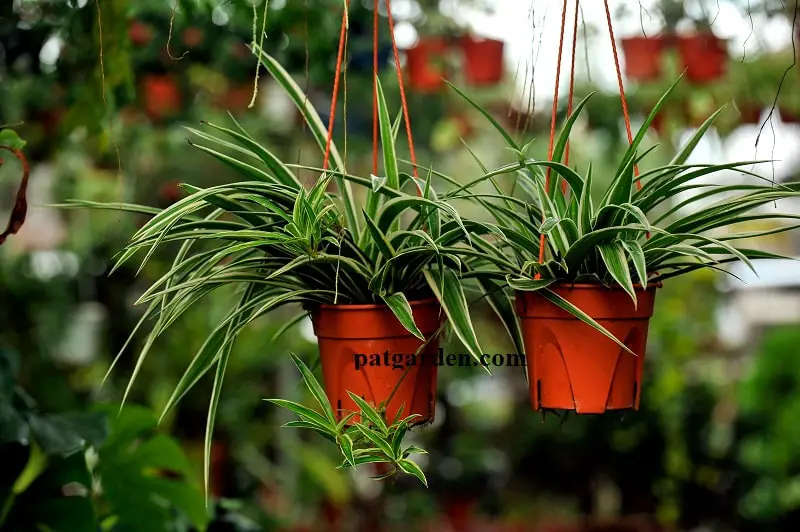
You May Also Like: Why Is My Spider Plant Dying?
Spider Plant Care Details
| Origin | Tropical and Southern Africa |
| Scientific Name | Chlorophytum comosum |
| Family | Asparagaceae |
| Common Name | Spider plantAirplane plant |
| Type | Hawaiian Spider Plant (Chlorophytum Viridescens)Variegatum (Chlorophytum Comosum)Zebra (Chlorophytum Laxum)Bonnie (Chlorophytum Comosum)Chlorophytum Comosum ‘Vittatum’ |
| Maximum Growth (Approx.) | Height 60 cm Leaves 45 cm. |
| Watering Needs | Little amount of water to keep the soil moist |
| Light Requirement | Thrive in bright indirect light |
| Humidity | Warm climate |
| Soil | Well-drained and rich in nutrients |
| Fertilizer | Liquid fertilizer free from fluoride and boron |
| Season | |
| Temperature | 65-85oF (18-29oC) |
| Flowering | Produce small white bloom during summer, spring and Fall. |
| Pruning | Occasional pruning is recommended |
| Propagation | Cuttings of a baby Spider plant |
| Re-Potting | Do not require frequently re-potting. It can only be done when the root ball protrudes above the rim of the pot. Repotting done in spring |
| Pests | Aphids, mealybugs, spider mites |
| Diseases | Tip burn, Fungal leaf and root rot |
| Toxicity | Non-toxic to cats and dogs |
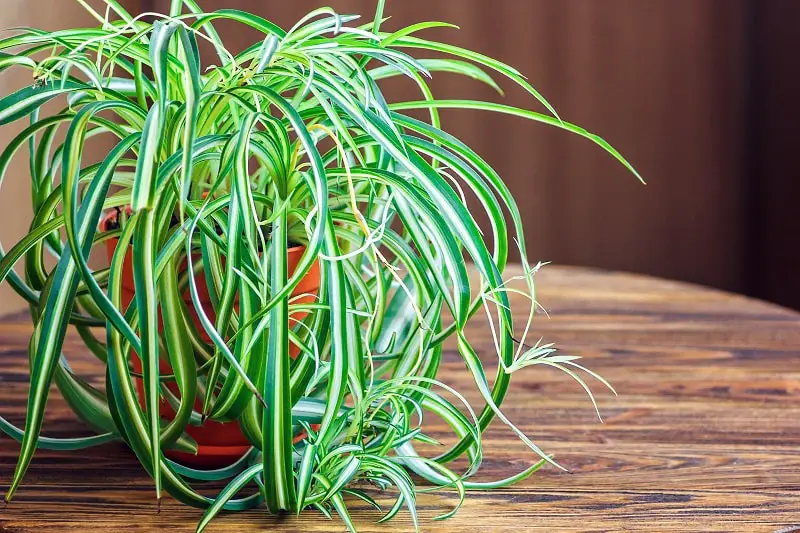
How to Care for a Spider Plant
Looking for a guide on how to take care of a spider plant indoor? Well, I have compiled some guidelines to help you grow spider plants successfully.
Here are tips for spider plant care indoors requirements:
Spider Plant Light Requirements
Spider plants thrive in bright indirect sunlight. The light enables the houseplant to develop vibrant colors and emergencies of spider plant babies.
One of my most superior features is that the plant can flourish outdoor during summer under low-light shade in zone 9-11.
Exposing the plant to direct sunlight will make the tips and edges of the leaves scorch. The houseplant consumes more water in bright light.
Keep in mind that stable green varieties need less light than green and white types. The latter varieties are more of spider plants outdoors.
How to Water Spider Plants
One of the most important is for spider plant indoor care is providing the required amount of water. These plants require a lot of water during spring and summer.
Provide less amount of water during winter. It is the period where the rate of transpiration and evaporation is relatively minimal.
You should note that these plants are highly susceptible to root and leaf roots. Overwatering will cause waterlogging, which later results in root rot.
Watering twice a week is advisable. But check the soil degree of dryness before watering. The good news is that the spider plant is invincible.
Here are other tips on how to water spider plants indoors:
- Check the dampness of the top inch soil before watering. If the level of the ground is dry, then consider watering the plant. Do not wait for the root ball to dry out since the houseplant might wilt or die.
- Spider plants are prone to root rot. So, ensure the pot has drainage holes to prevent waterlog from occurring. Cover the holes with pottery to avoid flushing out soil while watering.
- The houseplant is quite sensitive to minerals and salts. Use distilled water to prevent brown tips on the leaves from occurring.
- The plants need more water during summer and spring. Less water is required during winter due to low evaporation and transpiration rate.
Spider Plants Soil Requirements
Spider plants are tolerant of challenging conditions. But these plants flourish in well-drained soil due to proper aeration. The soil should slightly be alkaline with a pH level of about 6.0 and 7.2.
Besides that, the soil should be rich in nutrients and minerals that foster faster growth and development. Insufficient nutrients and minerals will make the plant have stunted growth.
Use general-purpose potting soil containing vermiculite. The soil does not experience waterlogging due to proper drainage, which prevents the occurrence of root rot in the plants.
Spider plants outdoors prefer sand soil mix to thrive due to sufficient drainage. Thus, reduce the chances of root and leaf rot symptoms as a result of waterlogging.
Prefer Average Humidity Level
The best condition for growing your spider plant is under low humidity. It is one of the reasons behind the better growth during winter.
Frequent misting during the summer will help the spider plant to flourish. Misting also prevents the houseplant from attacks by spider mites and other potential pests.
Exposing the houseplant to high humidity makes the tips start browning. The condition is expected during the summer.
Keeping the spider plant in the bathroom while taking a hot shower is one way of boosting the level of humidity in the plant.
Temperature Requirements for Spider Plants
Temperature is another crucial spider plant care indoors to be highly considered. The good news is that the plant does survive under normal indoor temperature conditions.
Keep the temperature between 70 and 90oF. But the houseplant can tolerate temperatures lower than 35oF. Remember, temperatures below 60-65oF make the plant have a slow growth rate.
Besides that, the temperature above 90oF makes the plant lose vital micronutrients. The most exciting thing is that the condition won’t damage the plant. But it will increase the transpiration rate.
How to Fertilize Spider Plant
Spider plants are not heavy feeders. But if you are looking to boost your houseplant’s growth rate, then it is advisable to apply fertilizer every 2-3 weeks.
Remember to apply fertilizer sensibly. Over-fertilization will cause brown leaf tips or even kill the entire indoor plant.
Growers are advised to stay away from fertilizers that contain fluorides and traces of boron. These ingredients harm the plant.
Use liquid fertilizer due to the ability to be absorbed faster by the plant. Stick to the instructions provided by the manufacturer.
Always fertilize the indoor plant twice a month during spring and summer. It is the period when the plant is more active and needs more nutrients to grow.
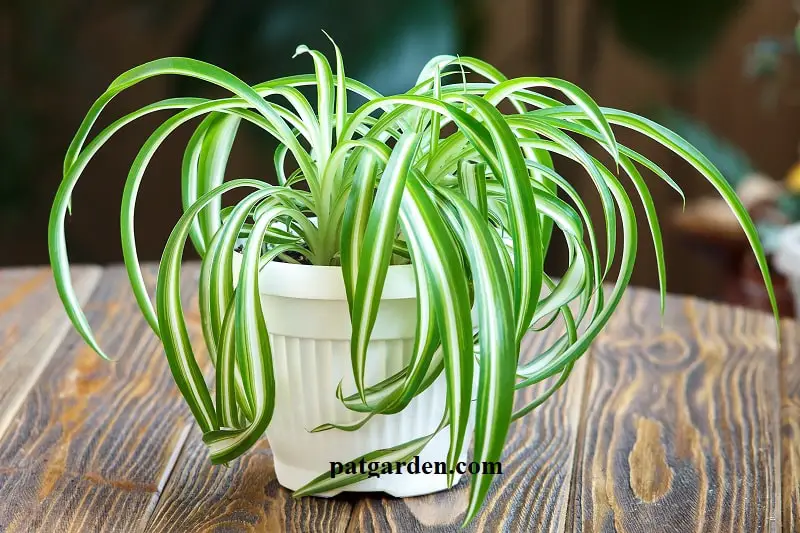
How to Propagate Spider Plant
Propagating spider plants is relatively easy and straightforward. Propagation takes place through cuttings and the removal of spider plant babies. Choose an option that works best for you.
If you are opting to use stem cuttings, then wait until the plant double in size. The method is only applicable to matured spider plants alone.
Here are steps for propagating spider plant babies:
- Get a pot with drain holes at the bottom. Fill the pot with nutrient-rich soil that has well-drainage.
- Wet the base of the spider plant baby and put into the soil
- Cover the base of the plant with more soil
- Ensure the soil is moist to trigger the rooting hormone
- Place the pot with spider plant baby under bright indirect light.
Here are other tips for propagating spider plants underwater:
- Fill a jar with distilled water and allow it to sit for 24 hours.
- Cut the plantlets of the plant and place them in water.
- Remember to replace the water every day and rub any buildup of molds.
- Keep the plant in water until it grows up to the mouth of the jar.
- Place the plant in the soil after the formation of roots.
How to Re-Pot Spider Plant
Re-potting is the process of moving spider plants from a smaller pot to a larger pot. It only happens when the plant outgrows the current pot.
The root system of spider plants tends to grow very fast. Re-potting the plant will help to prevent the current pot from cracking.
Re-potting spider plants are super comfortable. You need to uproot the plant from the pot gently and rinse to remove the soil.
Trim the roots and re-plant the plant in a larger pot. Ensure the pot has drainage holes and use general-purpose soil.
Place the spider plant at the bottom of the pot after filling it with some soil. Tuck the soil in the pot until all the roots are covered. Water the plant and create a conducive environment for growth.
Pruning and Trimming
Pruning dead leaf tips and baby spider plants is quite vital. It helps the houseplant to grow healthy leaves. Spider plant babies are removed by snipping off the most elongate stem from its base.
But pruning and trimming are done in spring or summer. Remember to snip off the brown leaf tips gently using a sharp shear.
Occasional pruning and trimming make the plant rejuvenated and even more beautiful. No need of hiring a professional trimmer.
Spider Plant Indoor Care Tips
- Water the plant moderately.
- Keep the soil moist during summer and spring.
- Maintain optimum room temperature and humidity
- Fertilize the plant twice a year during spring and summer
- Do not expose the plant to direct sunlight to prevent scorching of leaves.
Spider Plant Recommended Varieties
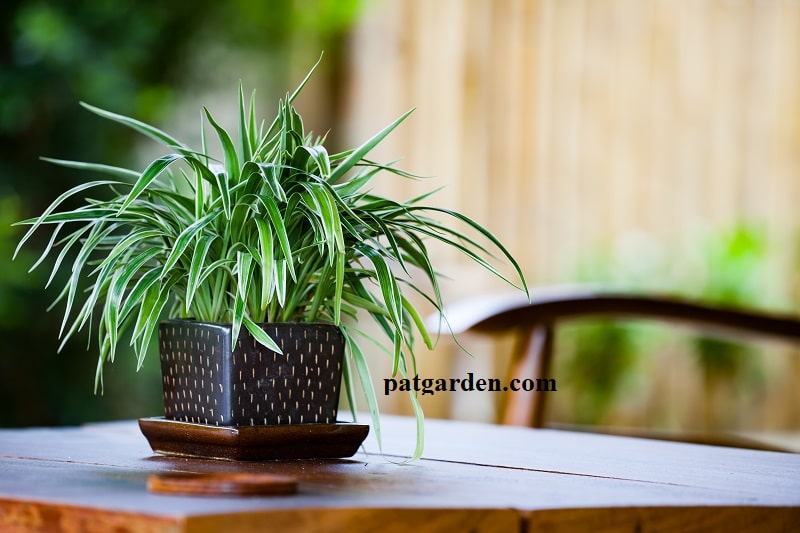
Spider plant species can withstand different climatic conditions. It is one of the reasons behind being the best foliage plant to grow indoors.
There are over 200 species of spider plants in the world. But here are some of the most popular indoor spider plants to consider:
Chlorophytum Comosum ‘Vittatum’
It is also known as Variegated Spider Plant. The species has white striped and slightly curved leaves marked with medium green colors. It is an excellent option for a hanging basket.
Bonnie
Also known as Chlorophytum Comosum. The species has some close similarities to that of Vittatum. But it comes with leaves that are more curled.
It is an excellent option for bathrooms and a small balcony. It grows very fast and needs a little amount of light. Many growers prefer to keep the plant in the toilet.
Zebra (Chlorophytum Laxum)
The spider plant species grow faster, and the leaves have yellow edges that turn white after maturity. Beginners are advised to consider the species and form a perfect option for small hanging pots.
Variegatum (Chlorophytum Comosum)
It is also known as Reverse Variegated. The most popular variety is grown in the United States of America. The plant is marked by arching leaves with white edges and dark green stripes in the middle.
But the variety needs bright indirect sunlight to bring out the wonderful variegation. Subjecting the plant to low light will hinder variegation.
Hawaiian Spider Plant (Chlorophytum Viridescens)
It is also known as Golden Glow. The species is small in size, and it has green leaves marked with a creamy champagne tone. It is an excellent option for the living room and simple to propagate.
Common Spider Plant Problems and How to Fix
Leaf Tip Burn
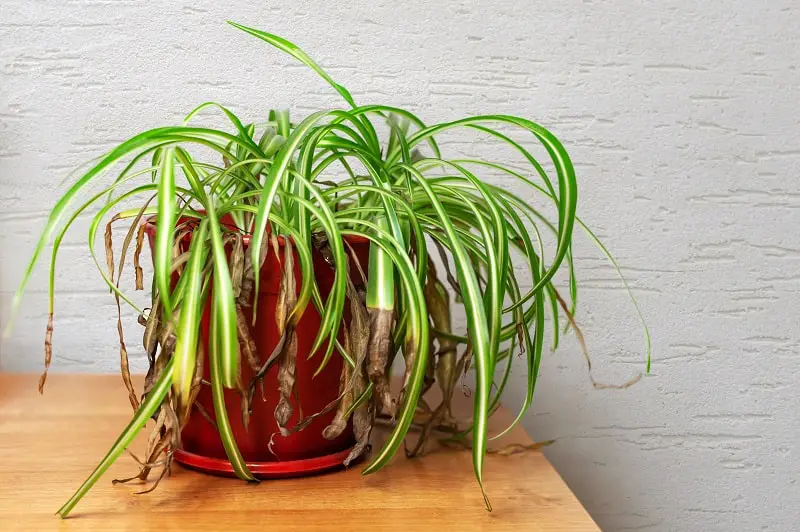
Spider plant leaves have white areas and necrotic tips. Watering the plant with tap water makes these tips turn reddish or brown due to fluorides. Sometimes, these leaves tips turn gray as a result of boron ingredients from water.
The best solution is to encourage the use of distilled water while watering the plant pot. Purified water lack minerals and chemical substances that cause discoloration.
You May Also Like: Why Does My Spider Plant Have Brown Tips
Bleached Foliage
Exposing the houseplant to too bright light makes the leaves start bleaching. The primary colors of the leaves will become discolored in case of prolonged exposure.
Place the plant in a semi-shaded area to resolve the problem. The plant does thrive in areas receiving indirect bright light.
Pests
The houseplant is highly susceptible to spider mites, mealybugs, and aphids. The infestation by these pests makes the leaves lose their vibrant colors.
The use of insecticidal soap pray happens to be the most excellent method to kill these pests. You can also opt to rinse the plant and rub it with alcohol swabs.
Is Spider Plant Species Toxic?
Spider plants are non-toxic to both dogs and cats. The hallucinogenic nature of the plant tends to attract the cat. The curiosity of the cats increases the chances of the animal ingesting the leaves.
Can a cat eat spider plants? Yes. But the chemical content of the leaves may make your feline experience stomach upset, vomiting, and even diarrhea.
It is advisable to avoid growing spider plants if you have cats at your home. There is no way you will stop these playful creatures from coming into close contact with the houseplant.
If your feline happens to have ingested the leaves from the plant, then it is recommended to seek immediate medical help. The good news is that the cat won’t die from eating the plant.
Will My Spider Plants Bloom Indoors?
Spider plants do develop small white flowers around the arching stems. But these flowers are inconspicuous and short-lived. The chances of not spotting these flowers are relatively high.
These blooms grow in clusters or sometimes as a single flower. But this typically depends on the variety of the spider plant.
Keep in mind that the over-fertilized spider plant does not bloom. The nutrients from the fertilizer only make the plant bushy with numerous plantlets.
How Long Do Spider Plants Live For?
Spider plants tolerate challenging conditions. It is one of the reasons behind the popularity in many homes across the world.
So, how long do spider plants live? The average lifespan is about ten years. But this depends on proper care and maintenance. If the plant is not taken care of properly, then it might die within some weeks.
Use the tips about spider plant care listed in the guide to have a healthy houseplant. Those tips have been tested and proven to be effective.
Do Spider Plants Attract Spiders?
The spider plant is one of the most grown houseplants in many American homes. But the houseplant can be too bushy if not pruned and trimmed occasionally.
The bushy design attracts pest infestations such as aphids, spider mites, and mealybugs. These pests tend to ruin the vibrant colors of the plant.
So, do spider plants attract spiders? Not really. The plant has nothing that can lure spiders into the pot. Instead, pests’ infestations is one of the major problem affecting spider plants.
Is Spider Plant Indoor or Outdoor?
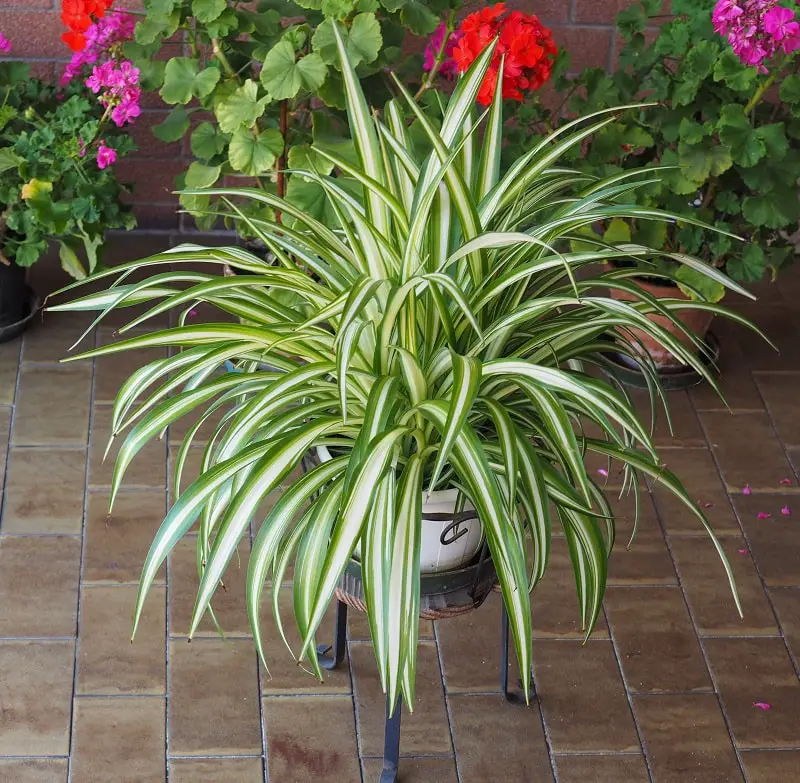
The native habitat of the spider plant is tropical South Africa. But in the United States of America, the plant is mainly grown as a houseplant.
So, is the spider plant indoor or outdoor? Both habitat. The plant is quite versatile and tolerant of different weather climates. Hence, they can thrive both indoors and outdoors.
If you plan to grow spider plants outdoor, ensure the area chosen to receive low light to prevent scorching the plant leaves from direct hot sunlight.
Can Spider Plants Live In the Bathroom?
A spider plant is a fuss option for beginners. The most exciting thing is that the plant can tolerate both low light and bright light.
But make sure the incoming light from the sun is indirect. This will help to prevent scorching of the leaves. The plant thrives in low humidity, which makes bathrooms and showers are a great place.
The environment in the bathroom creates a conducive surround for the plant to flourish. But do not overwater the plant since the environment experiences a low transpiration rate.
Final Thoughts from Experts
The spider plant is one of the most adaptable houseplants that are easy to grow and care for. It tends to form a great statement on the tabletop to the mantle.
One of the most exciting things about the plant is that it helps in air purification. The quality makes the plant provide additional health conditions in the house.
We hope the information provided in the guide about spider plant care will help you be a successful grower. Meanwhile, let us know if there is anything we have missed to mention in the comment section below.
You Can Also Read: Will Lettuce Grow in Winter?

I just got a little baby spider from my grandparents! I brought it home and placed it in a small jar with some water so the roots can grow and we can pot him, I really hope I can keep him alive ?
My spider plants leaves I’ve noticed started bending and snap apart with the slightest touch. Is this normal?
My spider plant started turning yellow on some leaves. Thank you for the tip about the kind of water, in my city the faucet water has fluoride. I have a few babies in a glass and they’re loving life.